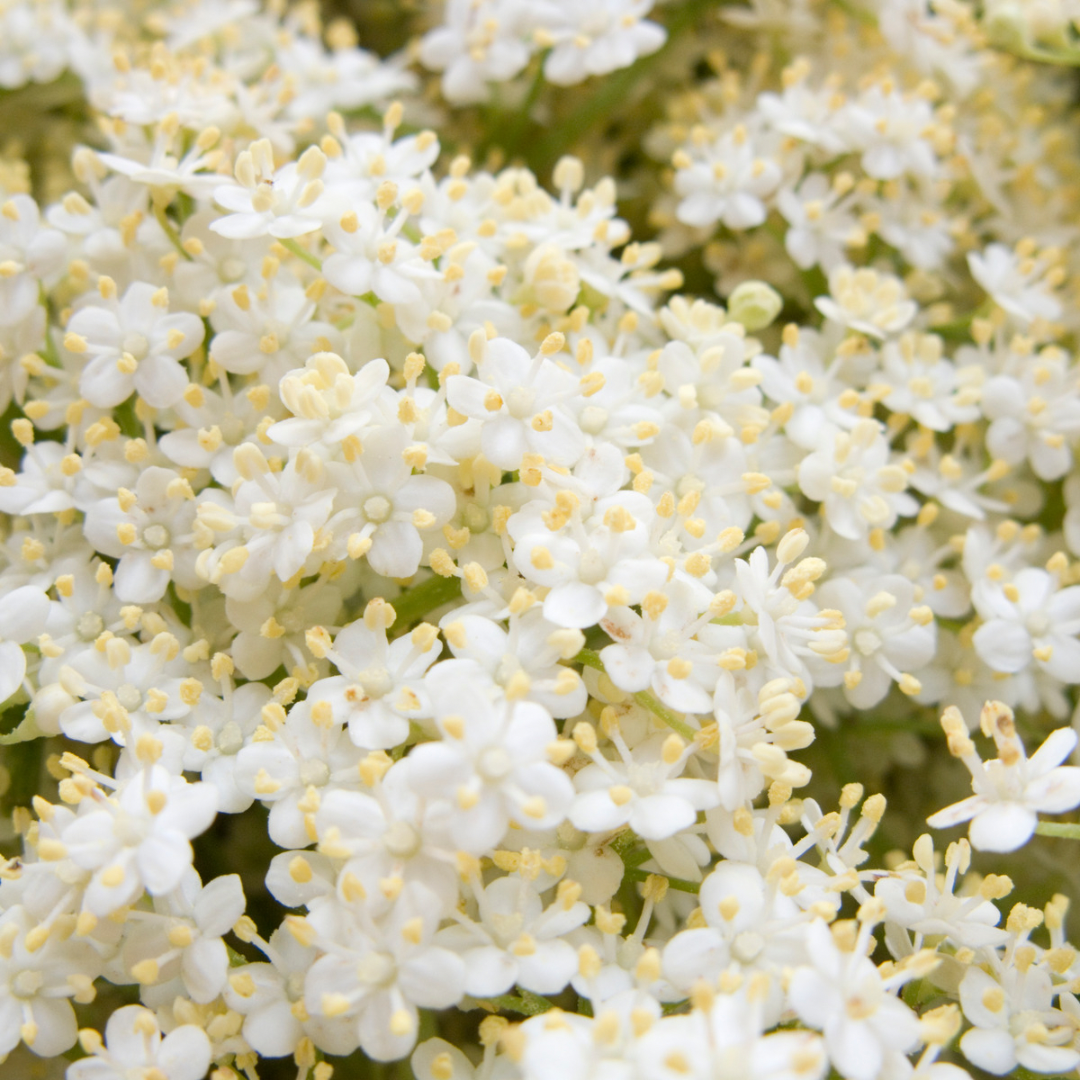”The smell of elderflower is now in the air and I use them in a multitude of ways. Here's is my thoughts on the wonderful flower and plant.
GeorgeFlavour Fred
We are coming into the fantastic season on elderflower but whats the best bit?
THE SEASON – late spring into summer
It is a beautiful day, walking through meadows with new crops up and as the sunshine hits you with its heat before a cloud quickly reminds you its not quite time for a t-shirt yet. With temperatures on the rise we find ourselves approaching summer and the signs are clear. Bees frequent the wildflowers or buzz into your door whilst preparing spring vegetables like asparagus or getting rhubarb ready for a must-have crumble and custard. One of my favourite times of year is upon us where the intoxicating scent of elderflower fills the air. Depending on where you are May up until July is the window where brushing past elderflower gives you a nudge of hope that getting out and exploring again does not require 3 changes of clothes.
Back to it. Some indicators of elderflower being close is that the cherry blossoms have begun to fall and filled the gutters or sides of streets and Hawthorn’s Mayflower is poking out. It’s the flower of the Elder (Sambucas nigra) that we are talking about and later in the year when the flower turn to its deep fruity and savoury berry we get another haul of a great wild ingredient. Its good to keep note of you favourite spots as once you take the flower you won’t be able to gather the fruit. For this reason I keep my picking of each item separate, always be respectful to your surroundings as its a huge pollinator, and loved by many other organisms. Its also prudent to check the fallen branches as you’ll probably find jelly ear mushroom throughout the year breaking down the dead elder wood which is always a welcome bonus.
INDENTIFICATION*
SAFE IDENTIFICATION
As we start to identify Elderflower initially from afar I start by looking what looks like balanced cream floral plates nestled amongst green foliage there are many other flowers out at this time that could be mistaken so its important to understand the key characteristics. A very common plant and its favourite environment is pretty broad including hedgerows, woodlands, garden edges, farmers fields, walkways, playing fields and commonly by canals. It’s everywhere in the UK and is also found in much of Europe, Western Asia, North and Central America.
We also need go be careful with the Elder itself as this deciduous shrub or small tree aside from the flower all parts of this plant are considered poisonous, even the berries should be cooked or prepared in ways to remove the cyanide inducing glycosides in the seeds. This always has some controversy due to the fact many have grown up eating them raw. I have also eaten plenty raw but there is a quantity that will have an affect which varies from person to person you’ll hear a similar warning you will heard of eating apple seeds and indeed you can derive the cyanide from stone fruits, which all contain this toxin. Taking a closer look it can be seen to grow to up to 6 meters and can grow as wide as it is tall. The bark is a light brown-grey and found with yellowing revealed in-between cracks. The leaves are light green, spear-shaped and have serrated edges they can be 5-12cm long and 3-5cm wide. They grow in opposing pairs of 5-7 leaves with one leaf at the end of the stem resembling a feather known as a “pinnate”. The flowers are 5-6mm in and are held in flat groupings that total 10-25cm in diameter. Later in the year elderberry once formed has a similar structure but due to its weight starts to droop. I have found that when picked they begin to juice themselves so very easy to collect the juice and there’s a lot that can be done with that including syrups, wines, vinegars, an old fermented British/French (unclear history) sauce to accompany game called “pontak” is also worth waiting to make – all of which go through a process that cooks the berry. We will wait for another article later in the year to go into more detail.
DANGEROUS LOOKALIKES
There are a few plants that Elderflower is confused with especially if you are just looking at the flower head. The Umbellifer (carrot) family whose flower head is like an upside down umbrella contains a number of plants, some of which, like poison hemlock, are very poisonous. The difference is quite clear as you are looking for a shrub/tree not a plant so check where the flower head is growing from and its an easy step to avoid this mistake on closer inspection. The main Umbellifer that could cause confusion especially with a young Elder would be Ground Elder whose leaves have a similar structure hence the name but once again it’s a low to the ground plant and that should be an early ID for those looking to collect and you won’t see the flowers anything like the clusters on elder. The Rowan Tree or Mountain Ash is a small tree that could be confused with Elder whose leaves are much finer and far more serrated, its bark is smooth silvery grey the Rowan tree is also much sturdier and you will notice the flower heads do not balance like elder but rather hang they are also more silvery grey than the creaminess of elderflowers and rarely get as large as elderflower heads. Rowan flower heads also have a strong almond flavour. The fruit later is the year is red or orange. You will maybe also be familiar with this tree as it lines many roads.
HISTORY, FOLKLORE & MEDICINE
The elder has a huge amount of folklore surrounding it. It is supposedly the on which Judas hung himself after betraying Jesus so has many bad connotations of it from that religion. There is also a lot of folklore about not burning elder in the house. It has a hollow that runs all the way through the middle of the branches that means it sucks in the flames as it burns. This creates a crackling and screaming coupled thick smoke and a terrible smell means it has developed a reputation for terrible firewood, not welcome in the house or witches will come for you…. I wouldn’t cook over it either but if I had no choice use it to get a fire going if nothing else was available.
This plant has been called the “medicine chest of country people”. There are a huge number of uses to go through but mainly the flowers are used by herbalists to aid inflammation within the respiratory system including asthma, coughs and hay fever. The berries are known as a super immune booster and all foragers I know make a syrup and take it throughout the winter months (you can buy a commercial version called “Sambucol” in Holland and Barrett or Waitrose – so a waste of money in my opinion).

RECIPES, USES OF ELDERFLOWER & PROCESSING PROPERLY
Edibility wise as we stated earlier we only use the flowers. Collect on a sunny day preferably the day after rain. Place the flower heads upside down on a flat surface to allow the bugs to crawl away for an hour. Its also important to use quickly as if they break down as there is a Ketone (4-thio-4-methylpentan-2-one) known as the “Cat Ketone” which exists in the leaves & flowers of currants like blackcurrant and is shared with elderflower that will become the prominent aroma and the only way to explain it is cat piss. Not nice I know but worth noting, essentially process it quickly to avoid this oh-dear aroma.
Ive tried many uses but the most popular for the flowers are normally sweetened such as;
- Cordials
- Natural sodas (fermentations like Elderflower ‘Sham’pagne)
- Wines, Infusions into spirits
- Flower head tempura
- Elderflower Sherbert is great especially playing with cocktails
- Infused into creams, custards, ice creams, sauces and cakes.
However I like to use them in savoury dishes and even trying to create floral flavours in curries. Here’s a couple of my favourite recipes

Elderflower & Mint Vegetable Medley
This is a simple savoury dish that requires little preparation and is finished in one pan (when I’m camping basically) showing the flavours of elderflower with other seasonal items you’ll find at present.
Serves 4 people, Prep time 20 mins, Cook Time 10 mins
|
Ingredients |
|
4 bountiful bunches of elderflower |
|
500ml Single Cream (or vegan cream) |
|
2 Lemons, halved |
|
500g Jersey Royals |
|
1 Bunch Fresh Mint |
|
50g Butter |
|
1 bunch Radish |
|
1 bunch Asparagus |
|
200g Cooked Chestnuts |
|
Seasoning |
- First of all we need to make the elderflower cream. It’s an infusion, place the elderflowers into a pot with the cream and lemons, bring to the boil. Once it has begun to boil you can remove from the heat and put the lid on. Allowing to further infuse then strain once the potatoes are ready in 20 minutes time. A rich elderflower infused cream will be used to finish the dish later. This can be done in advance and can also be used as a base cream for cheesecakes, served with pancakes. Its very versatile
- Next put a pot of salted water onto the hob and bring to the boil to blanch the potatoes. After 20 minutes check they are cooked through strain and set to one side on a flat tray to cool. This also can be done in advance
- Now we can begin to prepare the vegetables and nuts. The asparagus need to have the woody ends removed, the radishes can be cut into halves, crush the chestnuts and remove the leaves from the mint and chop roughly. The potatoes can be cut into discs
- Now its time to cook! This all takes place in one pan large frying pan or saucepan.
- Add the butter and put on the highest temperature allow the butter to melt and start to bubble then add the potatoes.
- Once the potatoes are coloured on both sides we can move the potatoes to one side, put on top of one another if need be and cook the radishes, repeat with the asparagus.
- Toss the vegetables together and add the chestnuts. Essentially we just want all the flavours to get amongst each other before adding the fresh mint and elderflower cream.
- Season to taste and serve
- Note: If you would like to use more than one pan the asparagus love being griddled or bbq’d which can be used on top of the dish to decorate
DRINKS & FERMENTING ELDERFLOWERS
Elderflower Tepache
Tepache is a popular drink in Central America essentially a natural soda from pineapple, chilli (optional), cloves, cinnamon and sugar. I’ve swapped out the pineapple for elderflowers here but kept the spices as it is such a great combination and is also great mixed with a beer for a floral shandy or a mixer for a vodka, gin and especially rum. It ferments naturally due to the wild yeast that is everywhere and if you’ve made elderflower sparkling wine before then this will bolster your elderflower and wild soda skillset to the next level.
Equipment
2 litre flip top jar (Kilner)
1 long-handled stainless steel spoon
1 reusable straw
1 sieve
2 x 750ml glass flip top bottles or plastic screw top bottles
|
Ingredients |
|
10 bountiful bunches of elderflower |
|
4-5 cloves |
|
1 cinnamon stick |
|
1 Chilli (optional) |
|
1.5 litres of water |
|
130g Sugar (organic is best) |
Preparation
I cannot express enough the importance of having all the bottles, glass and equipment clean. We are allowing sugar and yeast to ferment with the rest of the flavours in the recipe and it needs no other nasties to ruin this delicious recipe. We also need to respect the build up of carbon dioxide during fermentation. This process needs regular check on gas build and needs burping.
- Everything gets put into the flip-top jar. Close the jar and give it a good shake to mix the sugar. Open the jar to let out any gas and then seal again. This needs 4 days at room temperature to kick off the fermentation. Avoid direct light.
- After 4 days you should see the mixture is starting to foam. Let the gas out (burp), re-seal the jar and you can roll the jar around to mix everything up once more. Wait a few minutes and burp once more. Now leave for another day.
- On day 5 you can taste the mixture and see if you are happy with the flavour using the straw dipping it in like a fancy cocktail maker.
- If you are happy with it its time to strain. If its too sweet for you you can let it ferment at room temperature longer. Personally I like things a bit more sour and let it ferment another 3 days. Paying attention to the build up of pressure I burp it every day from here on in.
- Now we strain through a fine sieve and pour the liquid into clean bottles. Glass is best with a flip top but plastic bottles can also be used.
- I re-use the spent ingredients for another batch now and repeat the process. As its already been quite active it should only take 2 days rather than 4 indicated on step 2.
- The bottles I leave at room temperature again for 2 days to build up carbonation. Still burping on occasions and place in the fridge.
- It’s delicious and also full of natural probiotics. Win Win.
- Note: Releasing the pressure is very important and for this reason people use plastic bottles especially if they are keeping it in a cool dark place to ferment further. This will be creating a slightly alcoholic product that will be much more bitter.



